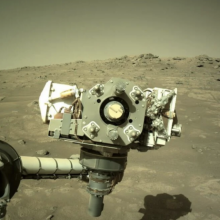After a year of exploring a mysterious valley on Mars, NASA's intrepid Curiosity rover is headed to a new destination with its own intrigue.
The Mini Cooper-sized robotic lab will study an unusual landscape, called a "boxwork," that likely necessitated warm groundwater to form eons ago on the Red Planet. And where there's water, there's potential for life — at least the kind scientists know about. Researchers wonder if the boxwork could have hosted ancient single-celled microorganisms.
"Early Earth microbes could have survived in a similar environment," said Kirsten Siebach, a rover scientist based in Houston, in a statement. "That makes this an exciting place to explore."
Since the mission launched in 2011, Curiosity has traveled about 352,000,020 miles: some 352 million whizzing through space and another 20 rumbling over the Martian terrain.
At its most recent site, known as Gediz Vallis, the rover literally stumbled upon pure sulfur, its wheels crushing the material to expose a bed of yellow crystals. It turns out there was a whole beach-like field of these rocks. Curiosity is surrounded by plenty of rubble that contains sulfur combined with other materials, but unadulterated sulfur is something special.
When pure sulfur is made naturally on Earth, the element is usually associated with superheated volcanic gasses and hot springs. Another way it can form is through interactions with bacteria — a.k.a. life.

"We don't think we're anywhere near a volcano where the rover is," Abigail Fraeman, deputy project scientist on the Curiosity mission, told Mashable in September, "so that is a puzzling feature to find in this particular location."
The next leg of the rover's journey will take a few months to drive. But scientists are eager to investigate the boxwork region at the foot of Mount Sharp because of what clues it could hold about Mars' ancient history.
From Mars Reconnaissance Orbiter images, the land feature looks like a spiderweb of ridges, spanning several miles. Dark sand fills the hollowed spaces among the lattice of ridges.

There are several kinds of landscapes on Mars that appear as interconnected ridges, though they're not all created in the same way. Near the Red Planet's south pole, for instance, is a labyrinthine feature nicknamed "Inca City," which may have formed after a meteor impact. The collision could have led to fault lines in the ground that were then backfilled with bubbling magma.
"Early Earth microbes could have survived in a similar environment."
Scientists believe this particular boxwork in Mount Sharp's foothills may have formed when minerals in the last trickles of water seeped into surface rock cracks and hardened. As the rocks weathered over the ages, minerals that had cemented into those fractures remained, leaving behind the boxwork.

Boxwork formations occur on Earth, but they're usually made with groundwater on cliffsides and in caves. The peculiar thing about the example at Mount Sharp is that it must have formed when water was vanishing. Geologists also aren't sure why this Martian feature is so vast, covering an area of six to 12 miles.
The rover team hopes to figure out whether microbes could have lived in that environment long ago.
"These ridges will include minerals that crystallized underground, where it would have been warmer, with salty liquid water flowing through," Siebach said.
UPDATE: Nov. 20, 2024, 5:48 p.m. EST An earlier version of this story incorrectly calculated Curiosity's mileage since it launched. It's about 352,000,020 miles.
Topics NASA















